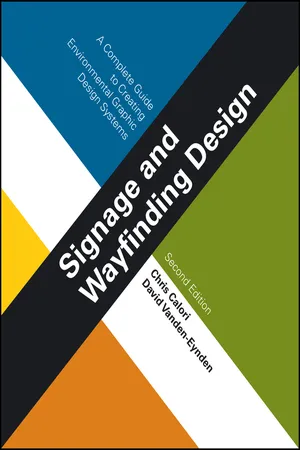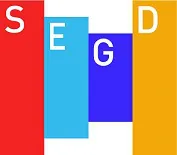
Signage and Wayfinding Design
A Complete Guide to Creating Environmental Graphic Design Systems
- English
- ePUB (mobile friendly)
- Available on iOS & Android
Signage and Wayfinding Design
A Complete Guide to Creating Environmental Graphic Design Systems
About this book
A new edition of the market-leading guide to signage and wayfinding design
This new edition of Signage and Wayfinding Design: A Complete Guide to Creating Environmental Graphic Design Systems has been fully updated to offer you the latest, most comprehensive coverage of the environmental design process—from research and design development to project execution. Utilizing a cross-disciplinary approach that makes the information relevant to architects, interior designers, landscape architects, graphic designers, and industrial designers alike, the book arms you with the skills needed to apply a standard, proven design process to large and small projects in an efficient and systematic manner.
Environmental graphic design is the development of a visually cohesive graphic communication system for a given site within the built environment. Increasingly recognized as a contributor to well-being, safety, and security, EGD also extends and reinforces the brand experience. Signage and Wayfinding Design provides you with Chris Calori's proven "Signage Pyramid" method, which makes solving complex design problems in a comprehensive signage program easier than ever before.
- Features full-color design throughout with 100+ new images from real-world projects
- Provides an in-depth view of design thinking applied to the EGD process
- Explains the holistic development of sign information, graphic, and hardware systems.
- Outlines the latest sign material, lighting, graphic application, and digital communication technologies
- Highlights code and updated ADA considerations
If you're a design professional tasked with communicating meaningful information in the built environment, this vital resource has you covered.
Frequently asked questions
- Essential is ideal for learners and professionals who enjoy exploring a wide range of subjects. Access the Essential Library with 800,000+ trusted titles and best-sellers across business, personal growth, and the humanities. Includes unlimited reading time and Standard Read Aloud voice.
- Complete: Perfect for advanced learners and researchers needing full, unrestricted access. Unlock 1.4M+ books across hundreds of subjects, including academic and specialized titles. The Complete Plan also includes advanced features like Premium Read Aloud and Research Assistant.
Please note we cannot support devices running on iOS 13 and Android 7 or earlier. Learn more about using the app.
Information
1
What Is Environmental Graphic Design?
Our need to hear and be heard, see and be seen, touch and be touched, that is, to communicate with our fellow humans, is fundamental to our well-being and, indeed, our survival.




SEGD

Table of contents
- Cover
- Titlepage
- Copyright
- Dedication
- Foreword to the Second Edition
- Foreword to the First Edition
- Acknowlegdements
- Introduction
- Chapter 1: What Is Environmental Graphic Design?
- Chapter 2: The Design Process
- Chapter 3: Overview of the Signage Pyramid Method
- Chapter 4: The Information Content System
- Chapter 5: The Graphic System
- Chapter 6: The Hardware System
- Gallery
- Image Credits
- Bibliography
- Index
- EULA